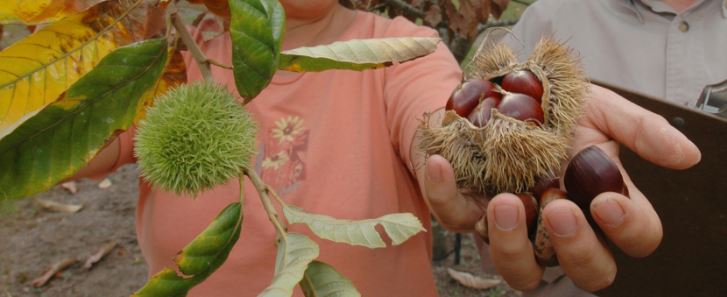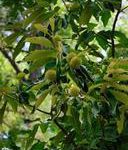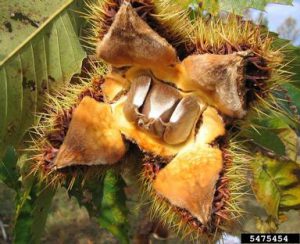The American chestnut tree, (Genus: Castanea dentata, Species: C. sativa, Family: Fagaceae) is a large monoecious deciduous tree. This big, beautiful tree provides green shade in the summer, a stunning array of fall foliage and a spinney cupule (bur) that holds and protects the chestnut during its growth and maturation. As its leaves begin to fall, so does the bur whereupon it splits and releases the chestnut. The American chestnut is important for both food and forage. This was of course until the American chestnut tree was devastated by chestnut blight-a fungal disease (Cryphonectria parasitica)) where upon it has been estimated that between 3 and 4 billion American chestnut trees were destroyed in the first half of the 20th century.
However, through scientific research it has been discovered that the Chinese chestnut tree (Castanea mollissima) is recognized as being highly blight resistant (but not immune). Many places in the United States have replanted the American chestnut tree with the Chinese chestnut and its cultivars. In fact, there are several chestnut orchards.
The chestnut is classified as a nut.
However, it differs from most nuts, as it is low in lipid (fat) content – approximately three percent. Nonetheless, the chestnut is nutritious; it contains carbohydrates, proteins and is rich in vitamins and minerals. The mature chestnut (nut pulp) is more than 50 percent water thus special care must be taken to extend its storage so that it does not spoil.
Local, fresh chestnuts are generally only available in the fall. A good chestnut is fairly large, firm to the touch and feels dense. The USDA does not have any standards for grades of chestnuts although sometimes size standards are based on the number of nuts per pound.
According to the American Chestnut Foundation® if fresh chestnuts are to be stored for eating, store them in a paper grocery bag for up to two months. Leaving fresh chestnuts at room temperature for a few days helps their starches convert to sugar. For longer storage, put chestnuts in the freezer and use immediately after thawing or they will become mushy.
Chestnuts can be eaten in a variety of forms –
- Fresh – dry roasted or boiled
- Frozen
- Dried
- Canned
- Pureed
- Ground into flour (obtained by grinding dried and peeled chestnuts)
Cooking methods for chestnuts vary widely too. Customarily though, chestnuts are Dry-Roasted in the oven, over hot embers, on top of the stove in a skillet, or even in the microwave. Once peeled, the chestnut can be pureed, added to soups, stews, stuffing’s, and vegetable dishes or even turned into a decadent dessert.
- Heat a skillet on top of the stove or preheat the oven to 425° F
- Rinse the chestnuts in cold water. (this removes any bird droppings etc….)
- Using a sharp knife, score the flat side of each chestnut nut with “X”. (The chestnut is FULL of moisture, the “X” keeps it from exploding.)
- Using a roasting pan or skillet place the chestnuts in the oven, over an open fire, or on top of the stove.
- Dry roast, stirring every five minutes until the shells begin to split open. (At this point the shells are brittle and have curled back some at the X.)
- Remove from the heat when the insides feel soft. (This will depend on the nut but usually about 15 – 20 minutes.)
- Peel the shells off the chestnuts and enjoy warm or cold.
The internet contains a wealth of chestnut recipes. One I particularly enjoy is Chestnut Hummus. Instead of using your favorite bean, prepare a pound of chestnuts by either boiling or dry roasting.
When cool enough to handle toss all of the traditional hummus ingredients into a food processor and process until smooth. Serve in your favorite bowl drizzled with a bit of extra oil and favorite accoutrements.
Chestnut Hummus
1 pound prepared chestnuts
1 whole lemon, juiced
¼ cup tahini or 1/4 cup sesame oil
1-teaspoon cumin, whole or ground (or your favorite seasoning! – have you tried harissa?)
¼-cup oil
½ cup hot water, more if necessary to make a good spreading consistency
Salt to taste
Serve with your favorite accompaniments. (crackers, fresh sliced vegetables etc.)
Bon Appetite!
- It’s Chestnut Season! - December 16, 2022
- Persimmons: Food of the Gods - November 23, 2022
- Have You Ever Thought About Entering Baked Goods in the North Florida Fair? - October 28, 2022



